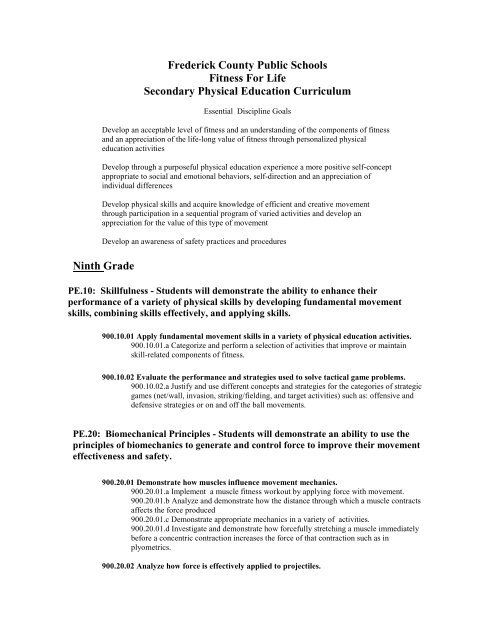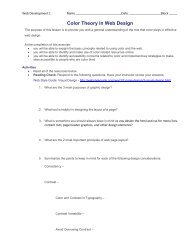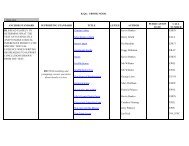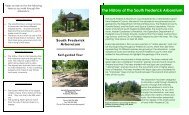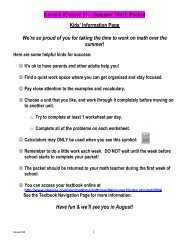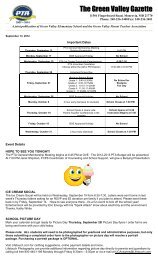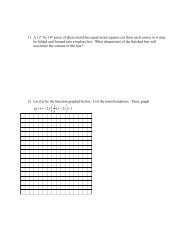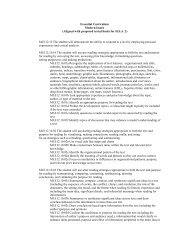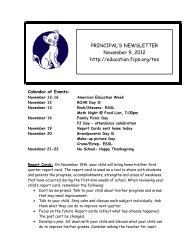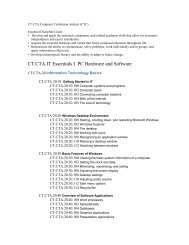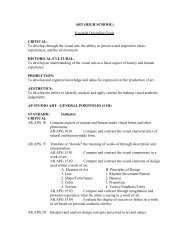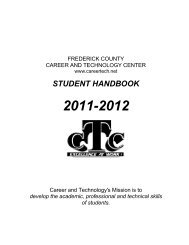Fitness for Life - Frederick County Public Schools
Fitness for Life - Frederick County Public Schools
Fitness for Life - Frederick County Public Schools
You also want an ePaper? Increase the reach of your titles
YUMPU automatically turns print PDFs into web optimized ePapers that Google loves.
<strong>Frederick</strong> <strong>County</strong> <strong>Public</strong> <strong>Schools</strong><br />
<strong>Fitness</strong> For <strong>Life</strong><br />
Secondary Physical Education Curriculum<br />
Essential Discipline Goals<br />
Develop an acceptable level of fitness and an understanding of the components of fitness<br />
and an appreciation of the life-long value of fitness through personalized physical<br />
education activities<br />
Develop through a purposeful physical education experience a more positive self-concept<br />
appropriate to social and emotional behaviors, self-direction and an appreciation of<br />
individual differences<br />
Develop physical skills and acquire knowledge of efficient and creative movement<br />
through participation in a sequential program of varied activities and develop an<br />
appreciation <strong>for</strong> the value of this type of movement<br />
Develop an awareness of safety practices and procedures<br />
Ninth Grade<br />
PE.10: Skillfulness - Students will demonstrate the ability to enhance their<br />
per<strong>for</strong>mance of a variety of physical skills by developing fundamental movement<br />
skills, combining skills effectively, and applying skills.<br />
900.10.01 Apply fundamental movement skills in a variety of physical education activities.<br />
900.10.01.a Categorize and per<strong>for</strong>m a selection of activities that improve or maintain<br />
skill-related components of fitness.<br />
900.10.02 Evaluate the per<strong>for</strong>mance and strategies used to solve tactical game problems.<br />
900.10.02.a Justify and use different concepts and strategies <strong>for</strong> the categories of strategic<br />
games (net/wall, invasion, striking/fielding, and target activities) such as: offensive and<br />
defensive strategies or on and off the ball movements.<br />
PE.20: Biomechanical Principles - Students will demonstrate an ability to use the<br />
principles of biomechanics to generate and control <strong>for</strong>ce to improve their movement<br />
effectiveness and safety.<br />
900.20.01 Demonstrate how muscles influence movement mechanics.<br />
900.20.01.a Implement a muscle fitness workout by applying <strong>for</strong>ce with movement.<br />
900.20.01.b Analyze and demonstrate how the distance through which a muscle contracts<br />
affects the <strong>for</strong>ce produced<br />
900.20.01.c Demonstrate appropriate mechanics in a variety of activities.<br />
900.20.01.d Investigate and demonstrate how <strong>for</strong>cefully stretching a muscle immediately<br />
be<strong>for</strong>e a concentric contraction increases the <strong>for</strong>ce of that contraction such as in<br />
plyometrics.<br />
900.20.02 Analyze how <strong>for</strong>ce is effectively applied to projectiles.
900.20.02.a Distinguish and demonstrate how projection speed and projection angle are<br />
related to accuracy such as: striking a tennis ball using a smash or a lob to have it land in<br />
the back corner of the court.<br />
900.20.02.b Calculate and demonstrate the concept of projection angles such as changing<br />
the projection angle to discover the influence on distance achieved.<br />
900.20.02.c Demonstrate and apply the effect of spin referring to ball trajectory and<br />
movement For example in tennis when topspin rebounds on a higher trajectory and<br />
backspin rebounds on a lower trajectory.<br />
900.20.02.d Investigate and demonstrate how balls can generate lift by spinning such as<br />
in soccer.<br />
PE.30: Motor Learning Principles – Students will demonstrate the ability to use<br />
motor skill principles to learn and develop proficiency through frequent practice<br />
opportunities in which skills are repeatedly per<strong>for</strong>med correctly in a variety of<br />
situations.<br />
900.30.01 Practice self-evaluation and feedback in the improvement of motor skills.<br />
900.30.01.a Per<strong>for</strong>m a self and peer evaluation <strong>for</strong> skill improvement using an<br />
appropriate assessment tool such as a checklist or rubric.<br />
Please note it is important not to use the assessment tools to compare peer per<strong>for</strong>mance.<br />
Rather the assessment tools are used to provide specific feedback on individual<br />
per<strong>for</strong>mance.<br />
PE.40: Exercise Physiology - Students will demonstrate the ability to use scientific<br />
principles to design and participate in a regular, moderate to vigorous physical<br />
activity program that contributes to personal health and enhances cognitive and<br />
physical per<strong>for</strong>mance on a variety of academic, recreational, and life tasks.<br />
900.40.01 Evaluate the effects of moderate to vigorous physical activity on the body systems.<br />
900.40.01.a Defend a fitness plan using knowledge of the body systems and principles of<br />
overload, progression, specificity, regularity, and individuality.<br />
900.40.02 Evaluate the components of the FITT guidelines to adjust levels of physical<br />
activity.<br />
900.40.02.a Align personal fitness goals based on fitness assessments.<br />
900.40.02.b Apply the use of components of the FITT guidelines to a personal fitness<br />
plan <strong>for</strong> consistency with fitness levels and goals.<br />
900.40.03 Evaluate the various components necessary to design a personal fitness plan.<br />
900.40.03.a Assess the physiological changes and benefits achieved through the<br />
implementation of a personal fitness plan.<br />
900.40.03.b Create and implement a personal fitness plan based on an assessment of the<br />
health-related fitness components and personal fitness goals.<br />
900.40.03.c Justify activities chosen to improve or maintain specific health-related fitness<br />
components as part of a personal fitness plan.<br />
900.40.03.d Design, justify and adhere to a personalized, outside-of-school physical<br />
activity program, consistent with one’s own health per<strong>for</strong>mance, interests and fitness<br />
goals.<br />
900.40.04 Justify the benefits of physical activity.
900.40.04.a Assess the benefits of physical activity as a motivating factor to positively<br />
affect exercise adherence.<br />
900.40.04.b Evaluate the advantages of physical activity <strong>for</strong> lifelong health and wellness.<br />
900.40.05 Evaluate the factors influencing daily physical activity.<br />
900.40.05.a Assess the effectiveness of strategies <strong>for</strong> overcoming personal,<br />
environmental, and/or social factors affecting physical activity level and revise those<br />
strategies that have been ineffective.<br />
900.40.05.b Examine personal motivating factors <strong>for</strong> adhering to a physically active<br />
lifestyle.<br />
900.40.06 Evaluate the impact of cultural and media perceptions on physical activity.<br />
900.40.06.a Assess various marketing practices and strategies that influence consumer<br />
decisions on the selection of exercise equipment, programs, and health clubs.<br />
900.40.06.b Justify the benefits of current fitness trends.<br />
900.40.06.c Discover community resources available to improve personal fitness.<br />
900.40.06.d Determine a set of criteria to evaluate the validity of personal fitness<br />
products.<br />
900.40.06.e Determine a set of criteria to evaluate health club facilities.<br />
PE.50: Physical Activity - Students will demonstrate the ability to use the principles<br />
of exercise physiology, social psychology, and biomechanics to design and adhere to<br />
a regular, personalized, purposeful program of physical activity consistent with<br />
their health, per<strong>for</strong>mance, and fitness goals in order to gain health and<br />
cognitive/academic benefits.<br />
900.50.01 Analyze and evaluate individual aerobic capacity/cardiorespiratory fitness.<br />
900.50.01.a Participate in a variety of activities designed to enhance aerobic<br />
capacity/cardiorespiratory fitness.<br />
900.50.01.b Assess personal levels of aerobic capacity/cardiorespiratory fitness using a<br />
standardized test.<br />
900.50.01.c Design, execute and revise a personal plan <strong>for</strong> aerobic<br />
capacity/cardiorespiratory fitness based on a fitness assessment and incorporating the<br />
principles of overload, progression, specificity, regularity, and individuality.<br />
900.50.01.d Use technology to monitor and assess individual heart rate.<br />
900.50.01.e Calculate target heart rate to reflect personal activity goals.<br />
900.50.01.f Investigate and assess sport/activity specific aerobic<br />
capacity/cardiorespiratory fitness programs.<br />
900.50.01.g Defend the importance of maintaining a healthy level of cardiorespiratory<br />
fitness.<br />
900.50.02 Analyze and evaluate individual muscular strength and muscular endurance.<br />
900.50.02.a Participate in a variety of activities designed to enhance muscular strength<br />
and muscular endurance.<br />
900.50.02.b Assess personal level of muscular strength and muscular endurance using a<br />
standardized test.<br />
900.50.02.c Design, execute and revise a personal plan <strong>for</strong> muscular strength and<br />
muscular endurance based on principles of overload, progression, specificity, regularity<br />
and individuality.<br />
900.50.02.d Examine concepts important <strong>for</strong> safe participation in everyday muscular<br />
strength and endurance activities.<br />
900.50.02.e Investigate and assess sport/activity specific muscular strength and muscular<br />
endurance programs.
900.50.02.f Defend the importance of maintaining a healthy level of muscular strength<br />
and muscular endurance.<br />
900.50.03 Analyze and evaluate individual flexibility.<br />
900.50.03.a Participate in a variety of activities designed to enhance flexibility <strong>for</strong><br />
various muscle groups.<br />
900.50.03.b Assess personal level of flexibility using a standardized test.<br />
900.50.03.c Design, execute and revise a personal plan <strong>for</strong> flexibility based on principles<br />
of overload, progression, specificity, regularity and individuality.<br />
900.50.03.d Examine concepts important <strong>for</strong> safe participation in everyday flexibility<br />
activities.<br />
900.50.03.e Investigate and assess a sport/activity specific flexibility programs.<br />
900.50.03.f Defend the importance of maintaining a healthy level of flexibility.<br />
900.50.04 Analyze and evaluate individual body composition.<br />
900.50.04.a Participate in a variety of activities designed to improve body composition.<br />
900.50.04.b Differentiate between body types and recognize personal strengths.<br />
900.50.04.c Design, execute, and revise a personal plan <strong>for</strong> body composition based on<br />
principles of overload, progression, specificity, regularity, and individuality.<br />
900.50.04.d Examine concepts important <strong>for</strong> safe weight management programs.<br />
900.50.04.e Investigate and assess sport/activity specific body composition programs.<br />
900.50.04.f Defend the importance of maintaining a healthy level of body composition.<br />
PE.60: Social Psychological Principles - Students will demonstrate the ability to use<br />
skills essential <strong>for</strong> developing self-efficacy, fostering a sense of community, and<br />
working effectively with others in physical activity settings.<br />
900.60.01 Support the understanding of safety in physical activity settings.<br />
900.60.01.a Evaluate safe practices <strong>for</strong> a variety of physical activities.<br />
900.60.01.b Discuss the relationship between core strength and proper posture in<br />
minimizing injury such as: lifting, carrying, and lower back care.<br />
900.60.02 Predict the relationship between ef<strong>for</strong>t and improvement.<br />
900.60.02.a Create challenging, attainable personal physical activity goals and make<br />
revisions based on personal values.<br />
900.60.02.b Discuss how ef<strong>for</strong>t and motivation in a self-directed activity leads to<br />
attainment of a goal.<br />
900.60.02.c Self evaluate, design, and revise a plan <strong>for</strong> attainment of personal goals.<br />
900.60.03 Demonstrate compassion and inclusiveness in physical activity settings.<br />
900.60.03.a Identify problems and create an action plan to work productively with others<br />
to achieve and maintain a peaceful, healthy environment<br />
900.60.04 Evaluate time management strategies.<br />
900.60.04.a Assess a daily physical activity plan and use appropriate solutions and<br />
strategies to overcome personal time barriers.


